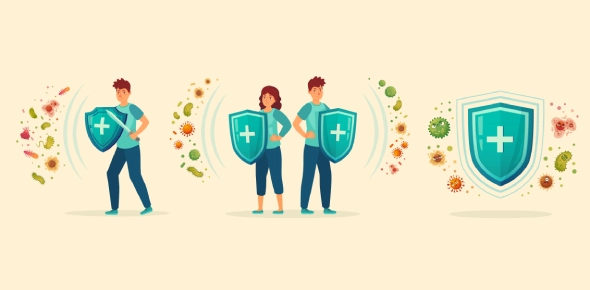The Immune System: An Easy Guide for Students and Classrooms
Lesson Overview
- Overview: Innate vs Adaptive Immunity
- Innate Immunity: The First Line
- Adaptive Immunity: Specific & Memory-Based
- Antibody-Mediated (Humoral) Immunity
- Cell-Mediated Immunity
- Antigen Presentation
- Hypersensitivity & Allergies
- Immunity Types: Active vs Passive
- Vaccines and Boosters
- Immune System Disorders
- Key Terms Recap
- Key Takeaway
The immune system is the body's defense mechanism against harmful invaders like bacteria, viruses, and toxins. It operates through two main branches: innate immunity and adaptive immunity. Understanding how these work and how various immune cells interact is critical for mastering immune-related quiz concepts and real-life biological understanding.
Overview: Innate vs Adaptive Immunity
| Feature | Innate Immunity | Adaptive Immunity |
| Response Speed | Immediate | Delayed (days) |
| Specificity | Non-specific | Highly specific |
| Memory Capability | None | Yes |
| Key Cells | Phagocytes, NK cells | B cells, T cells |
| Barriers & Chemicals | Skin, mucosa, lysozyme | Antibodies, cytokines |
Innate Immunity: The First Line
Innate immunity includes physical barriers like skin, chemical barriers like saliva and tears, and cellular defenses such as:
- Phagocytosis: Carried out by macrophages and neutrophils, this process engulfs pathogens without needing specific antigen recognition.
- Inflammation: Triggered by infection or injury. Characterized by redness, heat, swelling, and pain.
- Natural Killer Cells: These attack virus-infected and cancerous cells without specific antigen targeting.
- Interferons & Complement: Proteins that interfere with viral replication and help destroy microbes.
Adaptive Immunity: Specific & Memory-Based
Adaptive immunity develops after exposure to pathogens or vaccines. It includes:
- B Cells: Produce antibodies. Mature in the bone marrow.
- T Cells: Mature in the thymus and perform cell-to-cell combat.
Types of T Cells:
- Helper T Cells (CD4+): Activate B and T cells using lymphokines.
- Killer T Cells (CD8+): Destroy infected cells by creating holes and releasing lymphokines.
- Suppressor T Cells: Dampen the immune response post-infection.
- Memory T Cells: Retain antigen knowledge for rapid future response.
Antibody-Mediated (Humoral) Immunity
B cells differentiate into plasma cells, producing antibodies:
| Antibody Type | Function |
| IgG | Most abundant; crosses placenta for fetal immunity |
| IgA | Found in secretions like saliva, tears, breast milk |
| IgM | First produced during infection |
| IgE | Allergic reactions; binds mast cells |
| IgD | Involved in B cell activation (minor role) |
Antibodies neutralize pathogens, activate complement, and aid phagocytosis.
Cell-Mediated Immunity
T cells directly interact with infected or abnormal cells.
| Cell Type | Function |
| Helper T | Activate B/T cells, secrete interleukins |
| Killer T | Destroy infected cells |
| Memory T | Ensure faster secondary response |
| Suppressor T | Regulate immune activity |
Antigen Presentation
Macrophages engulf pathogens and display antigens on their surface using MHC molecules, which are then recognized by helper T cells. This bridges innate and adaptive immunity.
Hypersensitivity & Allergies
- Allergens are antigens that trigger allergic reactions.
- Exposure activates B cells to produce IgE, which binds mast cells.
- Upon re-exposure, mast cells release histamine causing:
- Vasodilation → Hypotension
- Bronchoconstriction → Wheezing
- Capillary leak → Swelling & rash
Anaphylaxis
A life-threatening allergic reaction with systemic histamine release.
| Symptoms | Outcome |
| Low BP, swelling, wheeze | Respiratory obstruction |
| Treatment | Epinephrine |
Immunity Types: Active vs Passive
| Immunity Type | How It's Acquired | Examples |
| Naturally Acquired Active | Infection induces immune response | Measles as a child |
| Artificially Acquired Active | Vaccination triggers memory response | Measles vaccine |
| Naturally Acquired Passive | Antibodies from mother (placenta or milk) | Breastfeeding, placental transfer |
| Artificially Acquired Passive | Injected antibodies | Antiserum, gamma globulin for rabies |
Active immunity is long-lasting; passive immunity is short-term.
Vaccines and Boosters
- Vaccines: Stimulate the formation of memory cells by exposing the body to antigens.
- Boosters: Given to re-expose immune memory and increase antibody titers.
- Titer: Measures the level of antibodies in the blood.
Immune System Disorders
HIV/AIDS
- HIV targets helper T cells, crippling the immune system.
- Leads to AIDS, where opportunistic infections become deadly.
Autoimmunity
- Immune system attacks the body's own tissues.
- Examples: Type 1 diabetes, lupus, rheumatoid arthritis.
Immunodeficiency
- May be congenital or acquired.
- Causes vulnerability to infections.
Key Terms Recap
| Term | Definition |
| Antigen | A substance that elicits an immune response |
| Antibody | Protein made by B cells to neutralize antigens |
| Histamine | Chemical causing allergy symptoms |
| Epinephrine | Hormone that counters histamine in anaphylaxis |
| Phagocytosis | Engulfing and destroying pathogens |
| Memory Cells | Retain pathogen information for faster future response |
Key Takeaway
The immune system functions through intricate cooperation between innate and adaptive mechanisms. Understanding how B and T cells work, the differences between humoral and cell-mediated responses, and the various forms of immunity is essential for mastering immunology. From defending against disease to the critical roles of vaccines, antibodies, and memory cells, this system ensures long-term protection and survival.
Rate this lesson:
 Back to top
Back to top

(141).jpg)